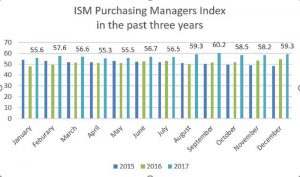By Jinman Li
Medill Reports
The U.S. manufacturing sector continued to show strong momentum in January, beating the market consensus.
The Institute of Supply Management reported Tuesday that its January purchasing managers index, or PMI, a composite indicator of the manufacturing sector, slipped 0.2 percentage point to 59.1 from a December reading of 59.3. A PMI reading above 50 percent indicates that the manufacturing economy is generally expanding, according to ISM.
Economists predicted an average of 58.7, according to Bloomberg.
“A change of this size can’t be meaningfully interpreted,” said Patrick Franke, U.S. economist at Helaba in Frankfurt, Germany, who describes the reading as an unchanged condition. “The strong momentum definitely continues.”
The weakened dollar, which makes U.S. manufacturing products more competitive in the international market, and the deregulatory policies under the Trump administration, contributed to the expansion, said Franke.
“The upturn of the global economy” is another driver behind the growth, which boosted new export orders 2.2 points higher to 59.8, said Louis Crandall, chief economist at Wrightson ICAP LLC, an economics research firm.
The new order index continued expanding for the 25th consecutive month, although it edged down 2.0 points to 65.4 from 67.4 in December. Of the 18 industry groups surveyed, 13 reported higher order volumes in January.
A similar case happened with the production index, which eased to 64.5, down 0.7 points compared with the month-ago reading, while maintaining a persistent strength.
“Production expansion continues, but due to employment and supplier delivery constraints, it could not keep up with new order input and customer inventory needs, resulting in higher backlogs,” wrote Timothy R. Fiore, chair of the ISM Manufacturing Business Survey Committee, in the release.
The employment index, which has been growing for 16 months, declined 3.9 points to 54.2 from December’s 58.1, suggesting a slower but still steady growth in manufacturing payrolls.

Despite the current uplifting figures, several components of the ISM data indicate further tightening in the manufacturing sector. The backlog of orders rose to 56.2, expanding for the 12th consecutive month. Supplier delivery times slowed for the 16th straight month. In the meantime, the price index surged to 72.7 from 68.3 in December, up 4.4 points, reaching its highest level since May 2011, when it registered 77.9 percent. This suggests an increasing price pressure for raw materials.
“When you get a reading up to 60, that’s nearly a boom. The most likely outcome here is that these commodity price gains and the gains you see in labor costs will probably translate into higher inflation,” said Stan Shipley, economist at International Strategy & Investment Group LLC.
Of the 18 surveyed manufacturing industries, 14 reported expansion in January and four reported contraction. The underperformance of the four industries, including printing & related support activities, wood products, furniture & related products, and nonmetallic mineral products, may be due to the abnormally cold weather in January in the Southeast, Crandall said.
“While a slowdown in motor vehicle sales and U.S. trade policy pose downside risks, the broad based expansion is likely to endure over coming quarters,” Richard F. Moody, chief economist at Regions Financial Corp., wrote in a note.
The next ISM report on manufacturing will be released March 1, 2018.


